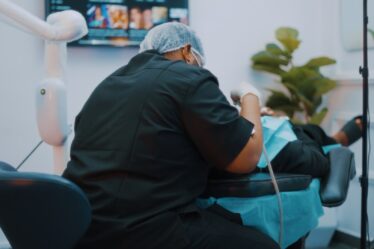
Stretch marks, those silvery streaks that often grace our bodies, are a common phenomenon that many of us encounter at some point in our lives. While they are entirely natural, it’s understandable if you’ve ever wondered, “What causes stretch marks?” In this ultimate guide, we’ll delve into the science behind these markings, explore the factors contributing to their appearance, and discuss ways to embrace and care for our bodies.
Understanding the Basics
Let’s start with the basics. Stretch marks, also known as striae, are scars that form when the skin undergoes rapid stretching or shrinking. They often appear as parallel lines and can vary in color, ranging from pink to dark brown. These lines may develop on various parts of the body, such as the abdomen, thighs, hips, breasts, and arms. If you’re struggling with stretch marks, professional treatments are available, such as https://dermatologyandlasergroup.com/body-procedures/stretch-mark-treatment-nyc/.
The Culprits: Why Do Stretch Marks Happen?
1. Rapid Growth or Weight Gain:
One of the primary causes of stretch marks is rapid growth or weight gain. The skin is a remarkable organ, but it has its limits. When the body expands too quickly, as is common during puberty or pregnancy, the skin’s elasticity can be tested, leading to the formation of stretch marks.
2. Hormonal Changes:
Hormones play a crucial role in skin health. During periods of hormonal fluctuations, such as pregnancy or adolescence, the skin can become more susceptible to stretch marks. Cortisol, known as the stress hormone, can also contribute to their development.
3. Genetics:
Genetics can influence whether an individual is more prone to developing stretch marks. If your parents or close relatives have them, you might be genetically predisposed to experiencing them as well.
4. Lack of Skin Elasticity:
Some people naturally have less elastic skin than others. This reduced elasticity can make the skin more prone to stretch marks, especially when subjected to rapid changes in size.
Debunking Stretch Mark Myths
Before we proceed further, let’s dispel some common myths surrounding stretch marks:
Myth 1: Only Women Get Stretch Marks
Contrary to popular belief, stretch marks are not exclusive to women. Men can and do get stretch marks, particularly during growth spurts or significant weight changes.
Myth 2: Stretch Marks Only Happen During Pregnancy
While pregnancy is a common time for stretch marks to appear, they can happen at any stage of life. Puberty, rapid muscle growth, and weight fluctuations are other common triggers.
Myth 3: There’s a Foolproof Way to Prevent Stretch Marks
Despite numerous products claiming to prevent or eliminate stretch marks, there is no foolproof method. Genetics and skin type play significant roles, and while certain creams may help with moisturization, they cannot guarantee complete prevention.
Caring for Your Skin
Now that we’ve unraveled the mystery behind stretch marks, let’s talk about embracing and caring for your skin:
1. Hydration is Key:
Keeping your skin well-hydrated can enhance its elasticity. Drink plenty of water, and consider using moisturizers or oils that promote skin hydration.
2. Balanced Diet:
A nutritious diet supports overall skin health. Foods rich in vitamins C and E, zinc, and collagen can contribute to the skin’s resilience.
3. Gradual Weight Changes:
If possible, aim for gradual rather than rapid weight changes. This approach allows your skin to adapt more effectively.
4. Self-Love and Acceptance:
Lastly, embrace your body, stretch marks and all. They are a natural part of life’s journey, a testament to the incredible resilience of the human body.
Seeking Professional Help: Navigating Your Skincare Journey
While stretch marks are a natural part of life, and embracing them is a beautiful mindset, it’s entirely understandable if you’re looking for ways to minimize their appearance or address related concerns. Seeking professional help can provide valuable guidance and options tailored to your individual needs.
1. Dermatologists: Your Skin’s Best Friends
Dermatologists are medical professionals specializing in skin health. If you’re seeking personalized advice on minimizing stretch marks or addressing specific skin issues, scheduling a consultation with a dermatologist is a proactive step. They can assess your skin type, discuss your concerns, and recommend suitable treatments.
2. Cosmetic Procedures: Tailored Solutions
In some cases, individuals may opt for cosmetic procedures to reduce the visibility of stretch marks. Procedures such as laser therapy, microdermabrasion, and chemical peels are designed to enhance skin texture and appearance. These interventions should be discussed with a qualified dermatologist who can guide you through the potential benefits and risks.
3. Topical Treatments: Nourishing Your Skin
Certain prescription creams and ointments may be recommended by dermatologists to improve skin texture and reduce the appearance of stretch marks. These topical treatments often contain ingredients like retinoids, hyaluronic acid, or glycolic acid, aiming to promote collagen production and skin regeneration.
4. Embracing Body Positivity: Professionals Can Help with Your Mindset Too
While professional assistance can offer tangible solutions for your skin, it’s equally important to address the emotional aspect of living with stretch marks. Mental health professionals, such as therapists or counselors, can provide support and guidance in fostering a positive body image and self-acceptance.
5. Communication is Key: Open Dialogues with Your Healthcare Team
Whatever route you choose, maintaining open communication with your healthcare team is crucial. Discuss your expectations, concerns, and any potential side effects of treatments. This collaborative approach ensures that you are fully informed and comfortable with the decisions you make regarding your skincare journey.
Conclusion: Embracing Your Unique Journey
In conclusion, understanding what causes stretch marks is the first step towards embracing them. Rapid growth, hormonal changes, genetics, and skin elasticity all play a role in the formation of these marks. By debunking common myths and adopting a caring attitude towards your skin, you can navigate this aspect of your unique journey with confidence.
Remember, your body tells a story, and each stretch mark is a chapter in that narrative. Embrace it, celebrate it, and above all, care for it with kindness and love. After all, it’s the only skin you’ll ever have, and it deserves to be cherished.



